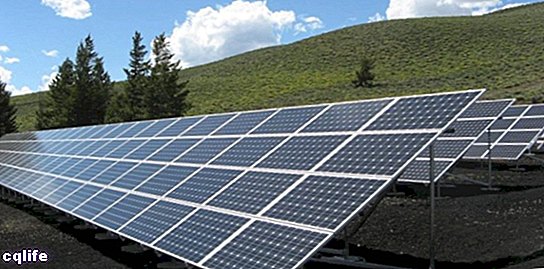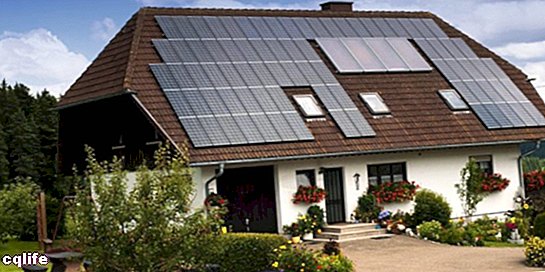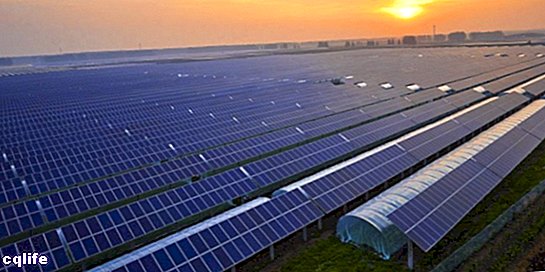- What is solar energy?
- Types of solar energy
- How is solar energy produced?
- What is solar energy for?
- Advantages of solar energy
- Disadvantages of solar energy
We explain what solar energy is and how it is produced. Also, what is it for, and what are its advantages and disadvantages.

What is solar energy?
Solar energy is a renewable form of energy, obtained from the transformation of electromagnetic radiation that comes from the Sun. This energy has been used by the life naturally since ancient times, and thanks to the technology Contemporary it is possible to receive and store it in photovoltaic cells or different types of thermal collectors, to take advantage of it for human purposes.
The sun constantly emits energy into space and much of it impacts the Earth, most are rejected by the atmosphere and dispersed to space, but the remaining 30% enters the planet and is absorbed by the oceans Y continents. Approximately 1000 W / m2 of energy enters our world in this way.
Solar radiation can then be converted into heat or electrical energy, with which to feed homes, industries and all kinds of mechanisms; It is a constant source (since the sun always emits), economic, not pollutant and energy safe.
Types of solar energy
The tools for harnessing solar energy can be passive or active, depending on their behavior:
- Active. Those that collect and store energy using photovoltaic devices and technologies thermal concentration.
- Passive The provisions that have to do with bioclimatic architecture, that is, the orientation of buildings to receive greater light natural, to prevent the dispersion of heat added by the Sun, etc.
How is solar energy produced?

Solar energy is a consequence, in the first place, of the atomic reactions that are constantly occurring inside the Sun, where there are large amounts of atoms merging and fissioning in a great natural nuclear reaction. This generates enormous amounts of heat and energy that are radiated to space and the planets.
This radiation reaches, as we have said, the surface of our planet, after having been filtered by the atmosphere. It is then received by two types of instruments:
- Photovoltaic cells. These are solar panels installed on roofs, rooftops or large areas of free land, made up of lots of silicon solar cells capable of converting solar radiation into electric power usable.
- Thermal collectors. These systems collect heat energy from solar radiation and allow its redistribution for practical purposes, such as heating, heaters and even electricity generation, since this heat can be used to boil water and move turbines.
What is solar energy for?
Solar energy holds many practical possibilities in today's world. The capacity of autonomy that photovoltaic installations provide to farms and settlements away from the electricity lines can be key in a better quality of life, as it translates to electricity consumable in different tasks and in heat for heaters of different types.
On the other hand, more and more countries are investing in this type of technology, which takes advantage of a natural resource constant to reduce the dependence of developed countries on the fossil fuels, As the Petroleum or coal, in obtaining energy. In fact, solar panels operate regularly in the satellites and space modules that humanity has sent into space, which is an example of the potential of this energy in the world to come.
Solar energy has, like everything, its positive and negative aspects.
Advantages of solar energy
- Ecology. Solar energy does not pollute, nor does it require complicated processes extraction of raw materials that harm the environment. In fact, it is compatible with the urban life.
- Saving. It is a cheap energy model, since the Sun radiates free to everyone and does not require the purchase of raw material, only technology investment and maintenance.
- Security. Solar energy does not have the risks to Health of atomic or fossil energy, and it is also a totally renewable model (as long as the sun exists, of course).
Disadvantages of solar energy

- Irregular. The production of this energy, since it depends on the amount of solar radiation perceived, fluctuates according to the weather, to the seasons and other climatic phenomena that can hinder the work and minimize the energy flow.
- Initial cost. Although obtaining the energy is very inexpensive, the installation costs of a solar plant are still quite high, given the amount of technology required.
- Site. Large areas of land are required to obtain high solar energy yields, and in many cases this is difficult to achieve. Desert areas tend to receive a lot of sun and have large plains available, but at the same time they are far removed from any human settlement.
